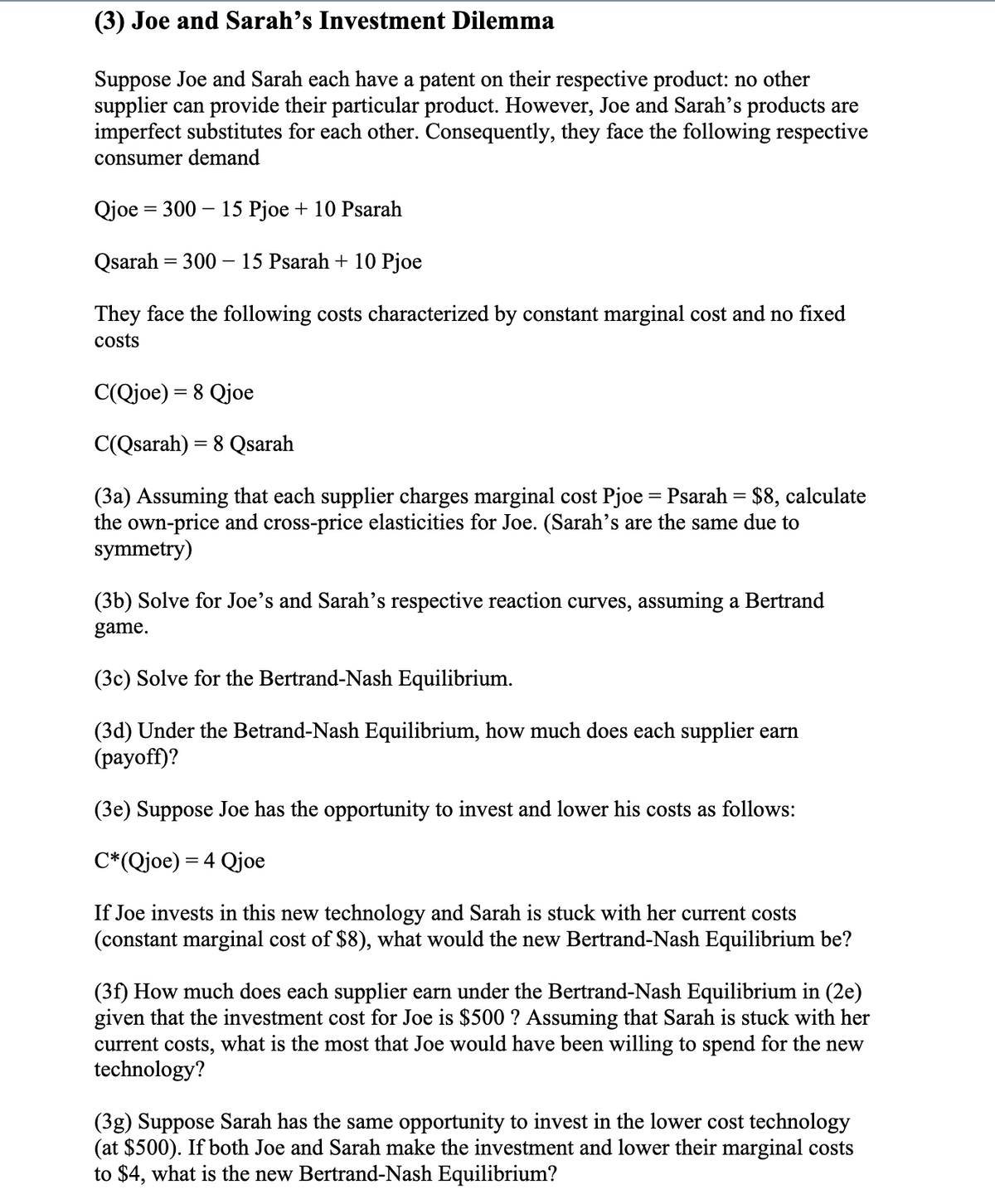(3) Joe and Sarah's Investment Dilemma Suppose Joe and Sarah each have a patent on their respective product: no other supplier can provide their particular product. However, Joe and Sarah’s products are imperfect substitutes for each other. Consequently, they face the following respective consumer demand Qjoe = 300 – 15 Pjoe + 10 Psarah Qsarah = 300 – 15 Psarah + 10 Pjoe They face the following costs characterized by constant marginal cost and no fixed costs C(Qjoe) = 8 Qjoe C(Qsarah) = 8 Qsarah (3a) Assuming that each supplier charges marginal cost Pjoe = Psarah = $8, calculate the own-price and cross-price elasticities for Joe. (Sarah's are the same due to symmetry) (3b) Solve for Joe's and Sarah's respective reaction curves, assuming a Bertrand game. (3c) Solve for the Bertrand-Nash Equilibrium.
(3) Joe and Sarah's Investment Dilemma Suppose Joe and Sarah each have a patent on their respective product: no other supplier can provide their particular product. However, Joe and Sarah’s products are imperfect substitutes for each other. Consequently, they face the following respective consumer demand Qjoe = 300 – 15 Pjoe + 10 Psarah Qsarah = 300 – 15 Psarah + 10 Pjoe They face the following costs characterized by constant marginal cost and no fixed costs C(Qjoe) = 8 Qjoe C(Qsarah) = 8 Qsarah (3a) Assuming that each supplier charges marginal cost Pjoe = Psarah = $8, calculate the own-price and cross-price elasticities for Joe. (Sarah's are the same due to symmetry) (3b) Solve for Joe's and Sarah's respective reaction curves, assuming a Bertrand game. (3c) Solve for the Bertrand-Nash Equilibrium.
Principles of Microeconomics (MindTap Course List)
8th Edition
ISBN:9781305971493
Author:N. Gregory Mankiw
Publisher:N. Gregory Mankiw
Chapter17: Oligopoly
Section: Chapter Questions
Problem 9PA
Related questions
Question
100%
a, b and c

Transcribed Image Text:(3) Joe and Sarah's Investment Dilemma
Suppose Joe and Sarah each have a patent on their respective product: no other
supplier can provide their particular product. However, Joe and Sarah's products are
imperfect substitutes for each other. Consequently, they face the following respective
consumer demand
Qjoe = 300 – 15 Pjoe + 10 Psarah
Qsarah = 300 – 15 Psarah + 10 Pjoe
They face the following costs characterized by constant marginal cost and no fixed
costs
C(Qjoe) =
Qjoe
C(Qsarah) = 8 Qsarah
%3D
(3a) Assuming that each supplier charges marginal cost Pjoe = Psarah = $8, calculate
the own-price and cross-price elasticities for Joe. (Sarah's are the same due to
symmetry)
(3b) Solve for Joe's and Sarah's respective reaction curves, assuming a Bertrand
game.
(3c) Solve for the Bertrand-Nash Equilibrium.
(3d) Under the Betrand-Nash Equilibrium, how much does each supplier earn
(payoff)?
(3e) Suppose Joe has the opportunity to invest and lower his costs as follows:
C*(Qjoe) = 4 Qjoe
If Joe invests in this new technology and Sarah is stuck with her current costs
(constant marginal cost of $8), what would the new Bertrand-Nash Equilibrium be?
(3f) How much does each supplier earn under the Bertrand-Nash Equilibrium in (2e)
given that the investment cost for Joe is $500 ? Assuming that Sarah is stuck with her
current costs, what is the most that Joe would have been willing to spend for the new
technology?
(3g) Suppose Sarah has the same opportunity to invest in the lower cost technology
(at $500). If both Joe and Sarah make the investment and lower their marginal costs
to $4, what is the new Bertrand-Nash Equilibrium?
Expert Solution
This question has been solved!
Explore an expertly crafted, step-by-step solution for a thorough understanding of key concepts.
This is a popular solution!
Trending now
This is a popular solution!
Step by step
Solved in 3 steps with 3 images

Knowledge Booster
Learn more about
Need a deep-dive on the concept behind this application? Look no further. Learn more about this topic, economics and related others by exploring similar questions and additional content below.Recommended textbooks for you

Principles of Microeconomics (MindTap Course List)
Economics
ISBN:
9781305971493
Author:
N. Gregory Mankiw
Publisher:
Cengage Learning

Economics: Private and Public Choice (MindTap Cou…
Economics
ISBN:
9781305506725
Author:
James D. Gwartney, Richard L. Stroup, Russell S. Sobel, David A. Macpherson
Publisher:
Cengage Learning

Microeconomics: Private and Public Choice (MindTa…
Economics
ISBN:
9781305506893
Author:
James D. Gwartney, Richard L. Stroup, Russell S. Sobel, David A. Macpherson
Publisher:
Cengage Learning

Principles of Microeconomics (MindTap Course List)
Economics
ISBN:
9781305971493
Author:
N. Gregory Mankiw
Publisher:
Cengage Learning

Economics: Private and Public Choice (MindTap Cou…
Economics
ISBN:
9781305506725
Author:
James D. Gwartney, Richard L. Stroup, Russell S. Sobel, David A. Macpherson
Publisher:
Cengage Learning

Microeconomics: Private and Public Choice (MindTa…
Economics
ISBN:
9781305506893
Author:
James D. Gwartney, Richard L. Stroup, Russell S. Sobel, David A. Macpherson
Publisher:
Cengage Learning

Principles of Economics 2e
Economics
ISBN:
9781947172364
Author:
Steven A. Greenlaw; David Shapiro
Publisher:
OpenStax